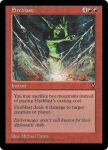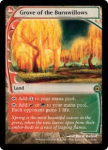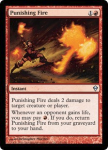I mentioned Burn, but Burn decks have changed considerably since the first time I put Cursed Scroll in mine. While Burn isn't especially popular in the current Legacy format and Cursed Scroll is unusual in those Burn decks that do come up in search results, the card does exist and can be played. Here's the most recent example I could find of a Legacy Burn deck running Cursed Scroll.
4 Goblin Guide
4 Monastery Swiftspear
4 Fireblast
4 Lightning Bolt
4 Price of Progress
4 Chain Lightning
4 Lava Spike
4 Rift Bolt
4 Skewer the Critics
4 Eidolon of the Great Revel
1 Cursed Scroll
9 Mountain
10 Snow-Covered Mountain
Sideboard:
2 Faerie Macabre
1 Karakas
4 Pyroblast
2 Searing Blaze
2 Searing Blood
4 Smash to Smithereens
This list has 12 slots taken up by creatures, which is too much for my own taste, but there is a rationale we can deduce here. Eidolon of the Great Revel doesn't need to attack to hurt the opponent, while the other creatures are the red one-drops that both have haste and hit the hardest for a single mana. And that's the point here: to outrace the opponent. Fully 20 of the noncreature spells in this deck are one-drops that do direct damage to the opponent. Cursed Scroll is also a one-drop. Basically, the only cards that can get stuck in hand without being available for a single mana are basic lands, Fireblast, and Price of Progress. Everything else is either a creature, a one-drop, or both. The direct damage spells tend to hit for at least 3 damage. The creatures are optimized to sneak in as much early damage as consistently as possible. Opponents in Legacy don't (with extremely rare exceptions) survive that onslaught, but they might disrupt it enough to make it nonlethal. Cursed Scroll is a one-drop insurance policy that can hit a weakened opponent multiple times and help ensure that the rest of the damage in the deck finishes the job. My favored trick of using it alongside Fireblast as the only card in my hand is a real option here. Another strong interaction (late-game for this deck, but not necessarily slow in absolute terms) would be to activate Cursed Scroll to hit the opponent with Skewer the Critics in hand, then follow up by casting Skewer the Critics for its discounted mana cost. Casting Cursed Scroll does trigger Eidolon of the Great Revel, but activating it doesn't, so that could help break the symmetry of the Eidolon in some games, although that's a cornercase.
This list is from September of 2020, showing up in a tournament after most of the posts in this thread so far. It does not explain the transition of Cursed Scroll in red decks from appearing more in Sligh to appearing more in Burn, as that had already taken place. But it does show what Burn is like these days, and that's a lot closer to what Burn was like 10 years ago than what Burn was like in 1997. We now have a critical mass of one-mana, three damage spells that can hit opponents. This was not always the case. Lava Spike, Rift Bolt, and Skewer the Critics didn't exist when Cursed Scroll was new. They didn't even exist when I wrote my Burn article at the CPA in 2004. Chain Lightning
did exist, but back then. Hasty creatures have been around for a long time and using them to try to get some early hits in for a Burn deck is nothing new; the ones that show up here are merely better versions of older options for this role. Eidolon of the Great Revel was a major development here, although really all it did was staple Pyrostatic Pillar onto a 2/2 body. The package of Fireblast, Price of Progress, Lightning Bolt, and Chain Lightning is classic. The trend, the evolution of this archetype, has simply been to find increasingly more Lightning Bolt analogs, even if they're conditional.
Sligh isn't really a viable archetype in Legacy in 2020, so I can't show an example of a Sligh list to contrast against this Burn list. But really, I think it's more meaningful to look toward historical lists anyway. Outside certain special environments, "Sligh" is kind of an obsolete term, a name associate with the days when red's aggressive creatures were so underpowered, you had to run Ironclaw Orcs and you had to like it.
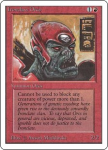
So here's the original Sligh list from 1996...
2 Dwarven Ruins
4 Mishra's Factory
13 Mountain
4 Strip Mine
1 Black Vise
4 Brass Man
2 Brothers of Fire
2 Dragon Whelp
3 Dwarven Lieutenant
2 Dwarven Trader
2 Goblins of the Flarg
4 Ironclaw Orcs
2 Orcish Artillery
2 Orcish Cannoneers
2 Orcish Librarian
4 Incinerate
4 Lightning Bolt
1 Shatter
1 Detonate
1 Fireball
Sideboard:
3 Active Volcano
1 An-Zerrin Ruins
1 Detonate
1 Fireball
4 Manabarbs
1 Meekstone
2 Serrated Arrows
1 Shatter
1 Zuran Orb
Obviously it's from a completely different format from that recent Legacy Burn list, and can't fairly be compared. They're on completely different levels. But it's no accident that this deck only dedicates 10 maindeck slots to direct damage spells and has 25 slots with creatures. It was expected that most of the damage to the opponent would be done with attacking. The direct damage spells, other than Detonate and perhaps Fireball, were generally pointed at blockers.
Now, for an example of Sligh decks
with Cursed Scroll, I'll cite the two that made it into the World Championship Decks product line. Both finished in second place. From 1998, there was Ben Rubin's Sligh deck.
4 Ball Lightning
2 Goblin Vandal
4 Ironclaw Orcs
4 Jackal Pup
4 Mogg Fanatic
2 Mogg Flunkies
1 Viashino Sandstalker
4 Fireblast
2 Hammer of Bogardan
4 Incinerate
4 Shock
4 Cursed Scroll
17 Mountain
4 Wasteland
Sideboard:
3 Bottle Gnomes
2 Dwarven Miner
2 Dwarven Thaumaturgist
1 Final Fortune
1 Firestorm
4 Pyroblast
2 Shattering Pulse
And from 1999, there was Mark Le Pine's "Sped Red." Notably, the first place deck also ran Cursed Scroll, although it was a Wildfire deck, rather than a Sligh deck.
4 Avalanche Riders
3 Fireslinger
4 Jackal Pup
4 Mogg Fanatic
4 Cursed Scroll
4 Shock
2 Arc Lightning
3 Hammer of Bogardan
4 Pillage
4 Stone Rain
2 Ancient Tomb
2 Ghitu Encampment
16 Mountain
4 Wasteland
Sideboard:
1 Arc Lightning
1 Fireslinger
1 Flowstone Flood
2 Masticore
4 Scald
2 Shattering Pulse
4 Thran Foundry
Format differences aside, what sets these decks apart from the Burn archetype is that they aren't running enough direct damage spells to kill opponents directly by throwing spells at them. Those spells might finish an opponent off once the opponent is badly damaged, but unless they're doing that, they're more likely to be used to get rid of blockers so that cheap red creatures can keep attacking. This keeps the opponent on the defensive and forces them into a spot where their mana isn't sufficient to fend off threats. Cursed Scroll as a reusable damage source would have been important here, as would Hammer of Bogardan (for the same reason).
There's a catch, and it's kind of simple. Once your environment has enough cheap red spells that hit opponents for decent damage, you might as well skip the middleman of attacking with creatures and just smack your opponent in the face with direct damage spells. This wasn't new knowledge. Experienced players from the beginning of the game would have known about dedicated Lightning Bolt decks from before the four-card rule was implemented.
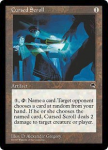 ≠
≠ 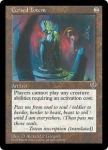
 ≠
≠ 

